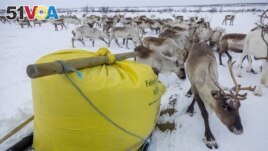06 April 2024
As he drives slowly across snow, Nils Mathis Sara drops food on the ground for hundreds of his reindeer to eat. His animals live in Finnmark, the northernmost point of Norway.
But Sara wishes he did not have to feed them.
"This is an emergency situation," said the 65-year-old Sara. "I am not supposed to feed them. They are supposed to feed me."

Reindeer that belong to Sami reindeer herder Nils Mathis Sara, 65, eat food pellets next to a bag containing the supplementary feeding for reindeer near Geadgebarjavri, up on the Finnmark plateau, Norway, March 13, 2024. (REUTERS/Lisi Niesner)
Sara is Sami, an ethnic group native to the northern areas of Norway, Sweden, Finland, and the Kola peninsula of Russia.
Normally, the reindeer find their own food. They dig through the snow to reach small plants, called lichen, buried below.
But every winter for the past ten years, Sara has had to buy food to help the animals live through the cold season. Winter temperatures in the area can drop to as low as minus 40 degrees Celsius.
Until recently, only snow fell during the winter months in Finnmark. But in recent years, the weather has been warmer, with temperatures sometimes rising above freezing. That means rain, instead of snow, falls on the ground. Then, when the temperature drops, that water turns to ice.
The thick ice makes it difficult for the reindeer to reach the lichen. "It is especially hard for the younger reindeer, as their hooves are not strong enough to break through," Sara said.
One morning in March, Sara and a family member put down about one and a half metric tons of food for the reindeer. The two men have been doing the same thing every other day since February.
"I should really be doing this every day, but economically it does not make sense," said Sara.
Feeding the animals can also bring unexpected results.
Later that day, Sara sees hundreds of reindeer in his reindeer feeding area. But, the reindeer do not belong to him.
Sara quickly drives over to the herder of the other reindeer. He asks the herder to move the animals out of the area. The reindeer had come to Sara's area because of the smell of the food Sara had put on the ground.
In addition, reindeer are semi-wild. Normally, herders follow the animals as they look for food under the snow. But feeding the animals makes them slowly become less wild and depend more on humans.
This makes the Sami people live more like farmers than herders. Sara says this goes against the Sami's traditional way of living.
"When we feed the reindeer, they change their behavior and become more accustomed to humans," Sara said. "This is not our way."
I'm Andrew Smith.
Gwladys Fouche wrote this story for Reuters. Andrew Smith adapted it for VOA Learning English.
_______________________________________________
Words in This Story
peninsula n.- a long piece of land that is surrounded by water on three sides
herder n.- a person who follows and looks after livestock such as cattle and goats
accustomed to adj. phrase – familiar with doing something or with a situation or state of being